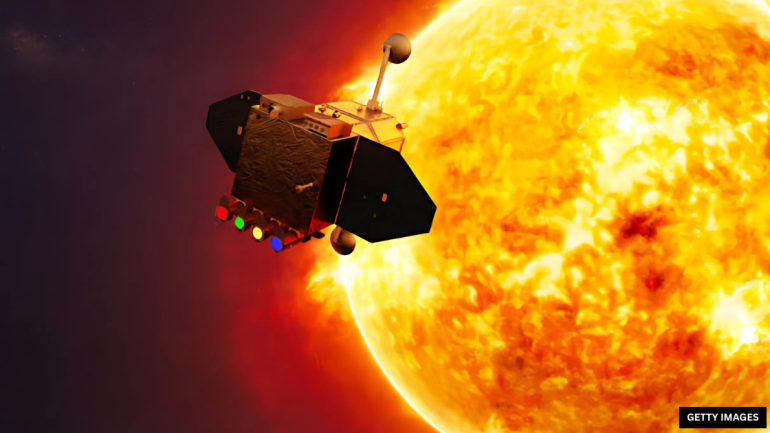NASA's Parker Solar Probe is making history, venturing closer to the Sun than any spacecraft has ever dared, braving unimaginable heat and radiation.
At just 3.8 million miles (6.2 million km) from the Sun’s surface, the probe has entered the star’s outer atmosphere. During this phase, it will endure intense conditions, going out of communication for several days. NASA scientists are holding their breath, waiting for a crucial signal expected on 28 December at 05:00 GMT to confirm whether the spacecraft has survived this daring maneuver.
Dr. Nicola Fox, NASA’s head of science, expressed both excitement and tension:
"This is humanity’s closest look at the Sun. The data we gather will transform our understanding of how stars work."
Lead engineer Dr. Mark Wilson added:
"The heat shield is performing as expected, but this is the ultimate test. We’re pushing the limits of what’s possible."
Mission operator Rachel Hayes shared the anticipation in the control room:
"The moment we hear that signal, it will feel like we’ve reached the Sun itself."
The Parker Solar Probe’s mission promises groundbreaking discoveries about the Sun’s behavior, potentially unlocking secrets about solar storms and their impact on Earth. As the world waits, the countdown to 28 December has begun.
What is the Parker Solar Probe?
The Parker Solar Probe is a small but mighty spacecraft. It’s about the size of a small car, but don’t let its size fool you—it’s packed with powerful technology! Scientists spent years designing the probe to handle extreme heat and dangerous radiation from the Sun.
To protect it, the spacecraft has a special heat shield called the Thermal Protection System. This shield can handle temperatures hotter than a pizza oven—up to 1,377 degrees Celsius (2,511 degrees Fahrenheit)! Without this shield, the Parker Solar Probe would melt before it even got close to the Sun.
The Parker Solar Probe was launched on August 12, 2018, from Cape Canaveral, Florida. Its mission was simple yet bold: to fly into the Sun’s outer atmosphere called the corona, and study how it works. Scientists want to know why the corona is so much hotter than the Sun’s surface and how solar winds—streams of charged particles—travel through space.
This spacecraft is named after Dr. Eugene Parker, a famous scientist who first explained solar winds back in 1958. It’s the first NASA mission named after a living person!
The Parker Solar Probe also has solar panels to collect energy from the Sun, but these panels are designed to fold away when it gets too close.
Famous Moments of the Parker Solar Probe
1. First Touch of the Sun (2021)
In April 2021, the Parker Solar Probe became the first spacecraft to “touch” the Sun. It flew into the corona, where temperatures reach millions of degrees! But don’t worry—the spacecraft has a special heat shield that keeps it cool. This moment was a huge milestone for space exploration. It was like shaking hands with the Sun for the first time!
2. Breaking Speed Records
The Parker Solar Probe is also the fastest spacecraft ever built. During one of its flybys in 2021, it reached speeds of about 430,000 miles per hour. That’s fast enough to travel from Earth to the Moon in less than an hour!
3. Approach to the Sun (2023)
In June 2023, the spacecraft flew closer to the Sun than ever before—just 4.3 million miles from its surface. To give you an idea, that’s like standing on your front porch and reaching out to touch a basketball hoop that’s 10 feet away. For a spacecraft, that’s practically touching the Sun!
4. The Next Big Moment: Closest-Ever Flyby (December 2024)
Now it broke the 2023 record on 28 December at 05:00 GMT and went closer to approximately 3.8 million miles.
Why Visit the Sun?
You might wonder, “Why would anyone want to go so close to the Sun? Isn’t it dangerous?” Well, the Sun is like the heart of our solar system. It affects everything around it, including Earth.
Scientists want to understand how the Sun works. They have big questions like:
Why is the Sun’s atmosphere so much hotter than its surface?
The Sun’s outer atmosphere, called the corona, is millions of degrees hotter than its surface. This is a mystery scientists want to solve.What causes the solar wind?
The Sun constantly sends out streams of charged particles called the solar wind. These winds can cause problems on Earth, like messing with satellites and power grids. Learning more about them can help us prepare for these challenges.How does the Sun create its magnetic fields?
The Sun’s magnetic fields are super strong and very complicated. They can cause big explosions called solar flares, which can be seen as bright flashes of light. These explosions can affect communication systems on Earth, so it’s important to understand them better.
The Record-Breaking Journey
The Parker Solar Probe is setting records with this mission. It’s the first spacecraft to fly into the Sun’s outer atmosphere, and it’s the fastest man-made object ever! At its top speed, it’s traveling at a whopping 430,000 miles per hour (700,000 kilometers per hour). That’s fast enough to go around Earth more than 15 times in just one hour!
The spacecraft doesn’t just fly straight into the Sun. Instead, it uses a clever path, looping around the Sun multiple times. Each time it gets a little closer, like a brave explorer carefully stepping into unknown territory.
The Dangerous Fly-By
Right now, the Parker Solar Probe is in the middle of one of its closest approaches to the Sun. This is called a fly-by, and it’s a really dangerous part of the mission. The spacecraft has to face intense heat and radiation while staying on course.
During this time, it can’t communicate with Earth because the Sun’s powerful energy blocks the signals. Scientists on Earth are anxiously waiting to hear from the probe. They expect to get a signal on December 28 at 5:00 AM GMT. This signal will let them know if the probe has survived its fiery journey.
What Will We Learn?
If everything goes as planned, the Parker Solar Probe will send back lots of information about the Sun. This data will help scientists answer their big questions and maybe even discover new things we didn’t know before.
For example, scientists might learn why the Sun’s corona is so hot or how the solar wind works. They could also find out how to predict solar storms better, which would help protect our satellites, power grids, and astronauts in space.
The Parker Solar Probe’s Legacy
The Parker Solar Probe is named after Dr. Eugene Parker, a scientist who made important discoveries about the Sun and solar wind. He was the first person to suggest that the Sun constantly sends out streams of particles into space.
Dr. Parker lived to see the spacecraft named after him launched in 2018, which was a very special moment. The Parker Solar Probe is carrying on his legacy by helping us understand the Sun better than ever before.
Why This Mission Matters
The Parker Solar Probe’s mission is not just about science—it’s also about inspiration. It shows us that humans are capable of amazing things. Building a spacecraft that can survive near the Sun is no small feat. It took years of hard work, creativity, and teamwork.
This mission reminds us to stay curious and keep exploring. Who knows what other exciting discoveries are waiting for us in the universe?
What’s Next?
The Parker Solar Probe’s mission is set to continue until 2025. By then, it will have made 24 daring flybys of the Sun. The data it collects will be studied for years to come, helping scientists unlock the secrets of our star. but for 2024 they are all set to catch the moment on 28th December.
In the future, other missions might build on the Parker Solar Probe’s discoveries. Maybe one day, we’ll send astronauts to study the Sun’s effects from even closer!
So, keep an eye on the news! The Parker Solar Probe is one brave little spacecraft, and its discoveries might change how we see the Sun and our place in the solar system.








